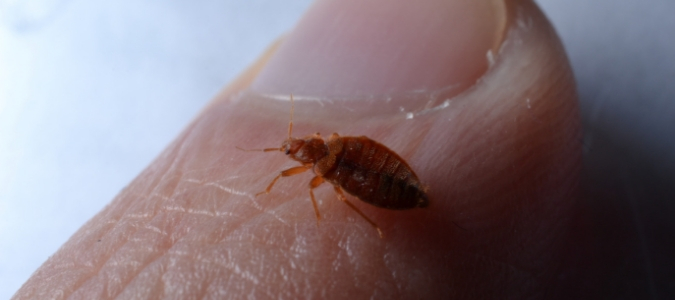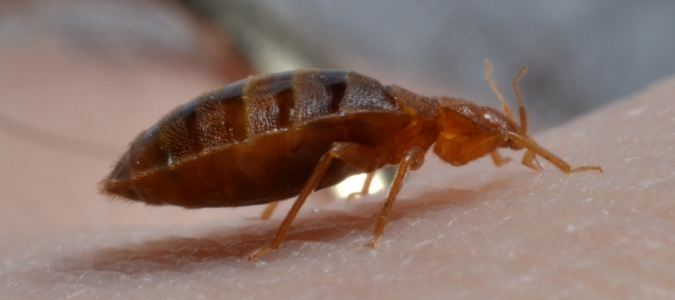
It’s an all-too-common scenario: You wake up one morning, or perhaps even several mornings in a row, with suspicious, itchy bites on your skin—and you wonder whether you might be dealing with a bed bug infestation. How can you tell if you’ve had a run-in with a bed bug or some other type of biting insect, such as mosquitoes, fleas, chiggers or ticks? Can you see bed bugs with the human eye? What are some telltale signs of a bed bug bite or a full-on infestation? Read on to learn the answers to these common questions and more.
How To Find Bed Bugs During The Day
For anyone wondering whether they can see bed bugs with the human eye, the short answer is yes—adult bed bugs are about the same size, shape and color as an apple seed, so they are certainly visible with the naked human eye. The longer answer, however, is a bit more complicated.
Bed bugs are active mainly at night for a reason: Nighttime is when they have the best chance of moving about unseen and feeding on the nutrient-rich blood of their deeply sleeping, unsuspecting hosts (that is, humans, as well as dogs, cats and other warm-blooded animals). Bed bugs are also sensitive to movement, so they prefer to feed on hosts that are still rather than moving around. That’s another simple reason why these insects most often feed at night, while people are resting peacefully.
During the day, bed bugs are far less active. Their bodies are very flat, about the same as the width of a credit card, so they are adept at squeezing into tiny cracks and creases in mattresses and furniture, between floorboards or between baseboards and walls. They can even sneak behind loose wallpaper! When bed bugs aren’t feeding, these pests spend their time hiding in these places, well away from view, as they digest their previous night’s meal.
This is why, if you suspect that you might have bed bugs in your home, it’s important to know how to find bed bugs during the day. Waking up once with suspicious bites on your skin can be alarming, but when it happens repeatedly, many homeowners start to suspect the presence of bed bugs. Since bed bugs are just one possibility among several for the source of the bites, it’s good to know what you’re looking for before you begin your search.
Here are some telltale signs that bed bugs may be living in your bed or other areas of your home:
- Dark-reddish-brown spots on mattresses, pillows, sheets and other bedding which could be spots of dried blood from crushed bed bugs.
- Tiny, black spots, about the size of a pepper flake that may be bed bug excrement. If you find these on your sheets or other bedding, you may find that this waste has bled into the fabric, just the way that ink bleeds.
- The cast-off exoskeletons of bed bugs. Like lots of other insects, bed bugs shed their skins when they molt from one phase of their life cycle to the next. You may spot these pale-brown skins left behind after a bed bug molting.
- Bed bugs themselves can of course be another surefire sign of a larger problem. Look for small, medium- or dark-brown, wingless, oval-shaped insects with flat bodies, six legs and two antennae. These parasites may be found either solo or clustered together along the seams of your mattress or box springs or in the cracks of floors, walls or baseboards, behind loose wallpaper or wall hangings or even inside the drawers of your furniture. You may also spot dead bed bugs or, alternatively, the tiny whitish eggs or larvae that indicate bed bugs are actively reproducing.
Can You See Bed Bugs During The Day?
You can see bed bugs during the day, but only if you know where to look and what you’re looking for. If you suspect that bed bugs are living in your home, use a flashlight to search along the seams of your mattress and box spring and in between them. You can also search along floorboards and baseboards, on the wall behind nightstands or around electrical outlets. These are all places where bed bugs themselves may be spotted, or where you might spot their small black droppings.
It’s far easier to see bed bugs’ bites during the day than to spot the insects themselves. The problem is, bed bug bites may not show up immediately after you’ve been bitten; also, bed bugs can go for weeks between feedings, which means you may not find bites on your skin every day, even if you do have an active infestation in your home. Furthermore, people often mistake bites from fleas, mosquitoes or ticks for bed bug bites.
Fortunately, there are a few hallmark qualities and distinct differences that can help you determine whether your bites came from a bed bug or from some other insect. Here are a few things to look out for:
- Do you have multiple bites that are close together in a line or small cluster? Bed bugs typically bite a person’s skin, feed at that site for a few minutes, and then move a few millimeters away to bite and feed at a new site. This results in lines or groupings of several bites in a row. Fleas and mosquitoes, on the other hand, will bite you anyplace they can reach, so their bites are typically more spread out and sporadic in their placement.
- Are your bites all over your body, or are they mainly on areas of your skin that were exposed while you slept, such as your arms, neck and face? Bed bugs tend to bite exposed patches of skin, while fleas might live under covers (especially if you have pets that spend time in your bed) and can, therefore, bite you anywhere on your body. Chiggers and ticks usually travel along a person’s body for a ways before settling down to take a bite. Chigger bites are often found along the lines where clothing compresses skin, such as along the skin beneath the waistband of your pants or underwear. Ticks often travel to tucked-away spots like armpits and belly buttons before settling in for a bite.
- Are your bites tiny, intensely itchy and possibly even blistered? Bed bug bites can be very itchy, and can even produce a burning sensation. They are usually small and can raise up in tiny, clear blisters. Mosquito and flea bites are more likely to be small, pinkish circles or larger welts, but without blisters or the intense itching and burning associated with bed bug bites.
How Do Bed Bugs Travel From Room To Room?
It’s easy for bed bugs to travel from one room to another, or even from one apartment or condo to another (if they have shared walls), simply by moving through cracks that are present in many homes’ walls and floors. This is why bed bug infestations have become so common and widespread in urban areas with high-density living situations such as apartment and condominium complexes. It’s also the reason why bed bugs can infest hotels so easily.
Serious bed bug problems are on the rise in larger cities like New York, San Francisco and even Houston, simply because there are so many people living closely together in buildings with shared walls between dwellings. This is just another explanation for how you get bed bugs. increasingly in residential areas. Often, these are older buildings with plenty of cracks—perfect for bed bugs looking to travel.
Where do bedbugs come from? Your bed bugs may have come from your luggage. Bed bugs travel from one room or home to another inside luggage, bedding or clothing. When these insects stow away in the seams of your suitcase or within your folded clothes, they can cause huge problems when they spread their infestation in a new place with new, fresh hosts to feed on. This is why it’s so important, when you stay in a hotel or any new bedroom, to do a thorough bed bug check before settling in.
Pull back the sheets so you can inspect the mattress and box springs for blood stains (or actual bugs, whether dead or alive). Keep your suitcases off the floor, elevated on luggage racks if possible. And if you plan to unpack and place your clothing inside a chest of drawers, use a flashlight first to check the corners and cracks within the furniture to make sure there are no bed bugs hiding out, waiting to crawl into your clothing.
Bed Bug Repellent For Body: Will This Protect My Family?
There is a bit of good news about bed bugs: Though they are often blamed for transmitting diseases, there is actually very little evidence that these insects have ever passed infectious bacteria or diseases to humans or other animals. This means they are much more of a nuisance than an actual health hazard. Still, that’s about the extent of the good news. People who react to bed bug bites can suffer many symptoms, including intense itching and hives, as well as redness, pain and swelling at the site of the bites. Victims of bed bug bites may also develop secondary infections if they scratch their bites too much. Furthermore, bed bug infestations can be very difficult and time-consuming, not to mention expensive, to eliminate.
For all of these reasons, many people who have had a run-in with bed bugs seek out effective ways to repel these insects, and may wonder whether a bed bug repellent for the body exists and is effective. Insect repellents containing DEET have been found to have some repellent value against bed bugs, and the higher the concentration of DEET in the product, the more effective it may be. Unfortunately, however, many scientists and pest control professionals claim that insect sprays and repellents have little to no effect on bed bugs.
Whether bug repellent products work to deter bed bugs or not, there are other ways to reduce the likelihood of a bed bug infestation in your home. These methods include keeping your living areas clean and clutter-free, since bed bugs can find more places to hide when there’s piles of clothing, excess bedding and blankets and other textiles and window treatments around your home. Homeowners wanting to prevent a bed bug infestation find it helpful to vacuum regularly, paying special attention to baseboards and cracks in wooden floors—any areas where bed bugs could hide during the day. You can also wash and dry your bedding and clothes on the hottest settings on your washer and dryer, as high temperatures can be effective in killing off these insects and their eggs and larvae.
ABC Can Solve Your Bed Bug Problem
Now you know some tips for keeping your home free of bed bugs, but infestations can still occur. While keeping living areas clean and clear of clutter can help, bed bugs have been known to move into even the cleanest and neatest of homes. If you have a bed bug problem that proves to be out of your control, simply call on ABC Home & Commercial Services to help. Our pest control professionals are experts in dealing with bed bugs. We will come to your home and conduct a thorough inspection to determine whether you have bed bugs or any other pest present. We will then develop a comprehensive plan to rid your home of bed bugs so you can sleep soundly at night, worry-free.



